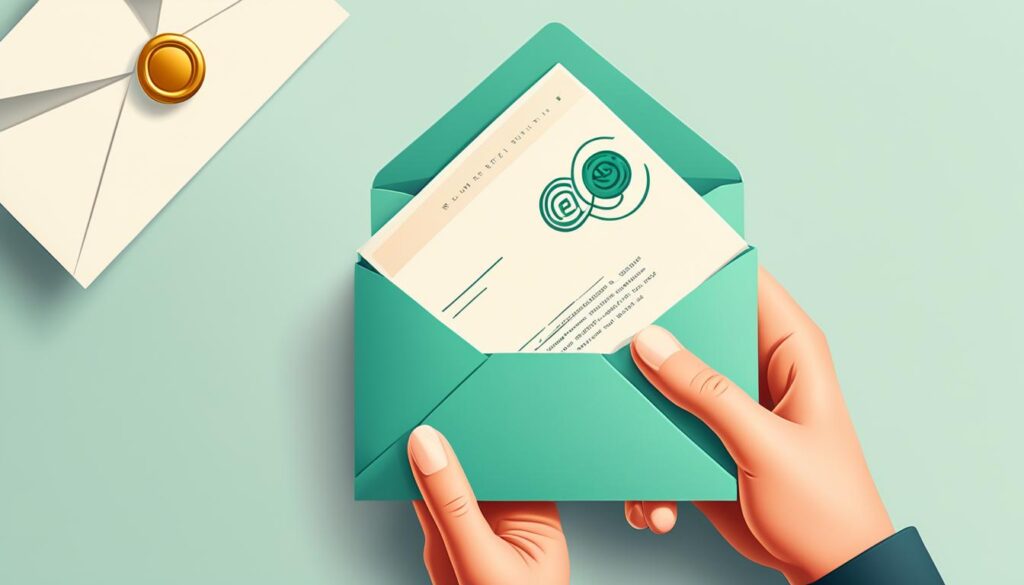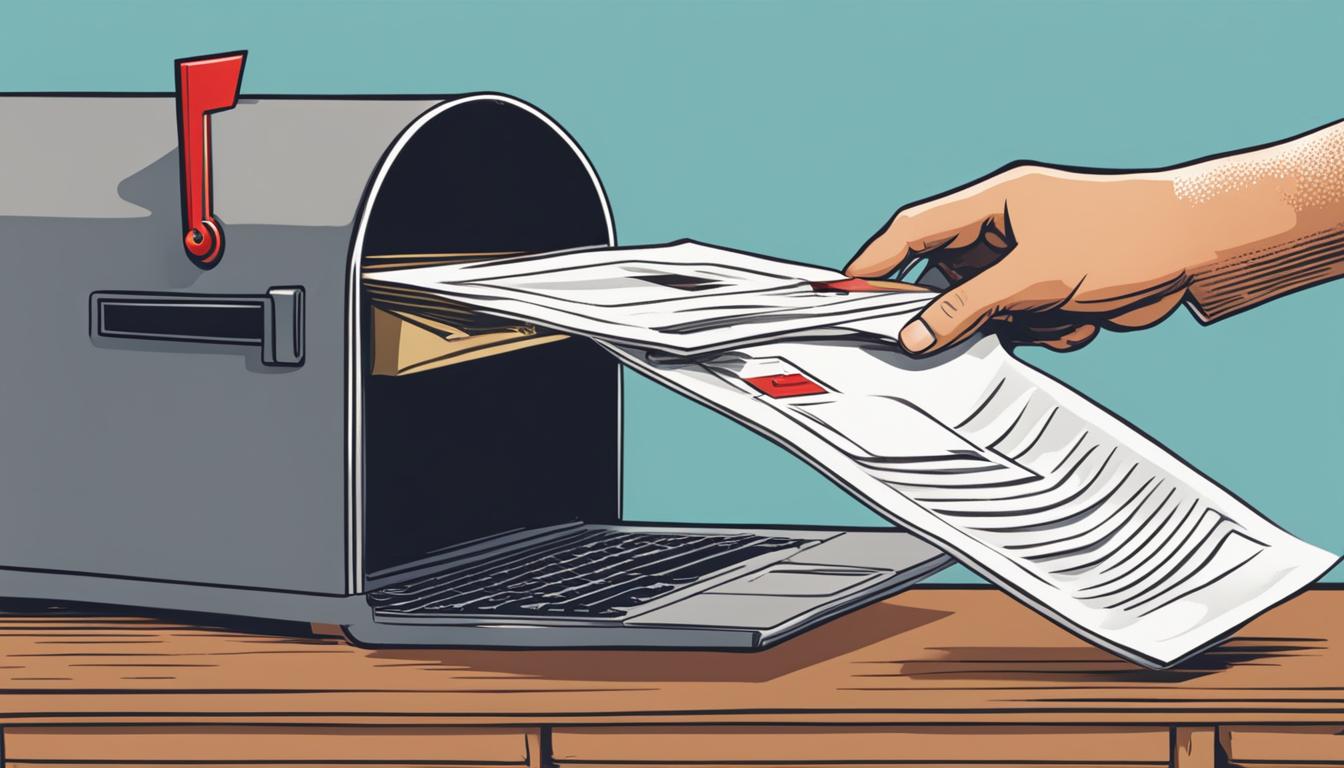Disclosure: This Post Contains Affiliate Links; We earn a commission on purchases.
Sending invitations for any event can be done in various ways, from traditional invitation cards to modern online invitations. This article will explore the art of sending invitations, covering everything from crafting the perfect card to choosing the right delivery method. We’ll discuss invitation templates, wording, and design, as well as how to manage RSVPs effectively.
Key Takeaways:
- Sending invitations can be done through email or traditional mail.
- Email invitations offer convenience, easy tracking of RSVPs, and quick distribution.
- Physical invitation cards add a personal touch and are suitable for formal events.
- Consider the nature of your event and the target audience when choosing the delivery method.
- Crafting the perfect invitation involves attention to design, wording, and relevant details.
Table of Contents
Sending Invitations via Email
One popular method of sending invitations is via email. This allows for easy distribution and tracking of responses. To send invitations via email, you can use email clients like Outlook or the Calendar app on iPhone. Both sources provide step-by-step instructions on how to invite attendees, add email addresses, and make invitations optional. Additionally, they explain how to schedule events without blocking your schedule and quickly email all attendees with event details.
Take advantage of the convenience and efficiency of email invitations. With just a few clicks, you can reach a large number of recipients and keep track of their RSVPs. Email invitations are especially suitable for informal events, such as parties or casual gatherings.
“Email invitations have made a significant impact on event planning. They allow us to streamline the invitation process, increase response rates, and easily communicate event details to our guests. Plus, with email tracking, we can easily follow up with those who haven’t responded.”
When sending email invitations, consider the design and tone of your message. Use a professional yet engaging template that captures the essence of your event. Include all the necessary details, such as the date, time, location, and RSVP instructions. Personalize the email by addressing each recipient by name, if possible. This creates a sense of importance and makes the invitation feel more personal.
Benefits of Email Invitations:
- Efficient distribution to a large number of recipients
- Easy tracking of RSVPs and follow-ups
- Cost-effective compared to printing and mailing physical invitations
- Quick communication of event details
Take a look at the following table for a comparison of sending invitations via email and traditional mail:
| Email Invitations | Physical Invitations | |
|---|---|---|
| Cost | Low (no printing or postage costs) | Higher (printing and postage expenses) |
| Time | Immediate delivery | Delivery time depends on postal service |
| Response Tracking | Easy tracking and follow-up | Manual tracking and follow-up |
| Convenience | Quick and easy distribution | Physical mailing process |
Sending invitations via email offers a convenient and efficient way to reach your guests. It allows for easy tracking of RSVPs and provides a cost-effective alternative to traditional mail. Consider the nature of your event and the preferences of your guests when choosing the right delivery method for your invitations.
Sending Invitations by Mail
For a more traditional approach, you can send physical invitation cards by mail. This adds a personal touch and allows guests to have a tangible reminder of the event.
When sending invitations by mail, you can follow the instructions provided by the second source. They explain how to send mail from a shared mailbox and reply to mail sent to the shared mailbox. This is useful for businesses or organizations that handle multiple email accounts and want to maintain a consistent email address for correspondence.
Benefits of Sending Physical Invitations
There are several reasons why sending physical invitations can be advantageous:
- Personal Touch: Physical invitation cards offer a more personal and tangible connection to your event. Guests can hold and display the invitation, creating a sense of anticipation and excitement.
- Tangible Reminder: With physical invitations, guests have a physical reminder of the event. It can serve as a visual cue that prompts them to save the date and make arrangements to attend.
- Distinctive Design: Physical invitations allow for creative and unique designs that can complement the theme or style of your event. From elegant paper stock to intricate details, the design possibilities are endless.
- RSVP Cards: Including RSVP cards with pre-addressed envelopes makes it convenient for guests to respond. It streamlines the RSVP process and ensures an accurate headcount for planning purposes.
To enhance the overall experience and make your physical invitations stand out, consider incorporating custom designs, calligraphy, and thoughtful packaging.
Additional Considerations
When sending invitation cards by mail, there are a few important factors to keep in mind:
- Timely Delivery: Plan the mailing of your invitations in advance to allow sufficient time for them to be delivered. Consider the postal service delivery times, especially when sending to international guests.
- Accurate Addressing: Double-check the addresses of your guests to ensure accurate delivery. Incorrectly addressed invitations may not reach their intended recipients.
- Postage: Make sure you have the correct postage for each invitation to avoid any delays or returns. Weigh your invitations and consult with your local postal service for the appropriate postage rates.
| Pros | Cons |
|---|---|
| Personal and tangible connection | Requires more time and effort |
| Tangible reminder of the event | Higher cost compared to digital invitations |
| Creative design possibilities | Potential for delivery delays or errors |
| Convenient RSVP cards | May have limited tracking and response visibility |
Despite the digital age, physical invitation cards still hold a special place in event planning. The tactile experience, attention to detail, and personalization make them a cherished memento for both hosts and guests.
Choosing the Right Delivery Method
When it comes to sending invitations, choosing the right delivery method is crucial. Consider the nature of your event and the convenience for your guests.
Email invitations offer a quick and cost-effective solution. They allow you to easily track RSVPs and ensure efficient communication. With just a few clicks, you can reach all your guests and receive their responses promptly. Email invitations are particularly suitable for casual parties, corporate events, and informal gatherings. They offer convenience and flexibility for both the host and the guests.
On the other hand, physical invitations can create a sense of excitement and anticipation. Holding a beautifully designed invitation in their hands adds a personal touch for the recipient. Physical invitations are especially suitable for formal events such as weddings, black-tie galas, and milestone celebrations. They convey a sense of importance and elegance that is hard to replicate with email.
When deciding between email and physical invitations, consider your target audience and the message you want to convey. Think about the convenience factor and the overall experience you want to provide for your guests. Email invitations are convenient and efficient, while physical invitations add a touch of elegance and charm.
Comparison Table: Email Invitations vs. Physical Invitations
| Email Invitations | Physical Invitations |
|---|---|
| Quick and cost-effective | Create a sense of anticipation and excitement |
| Easy tracking of RSVPs | Add a personal touch |
| Convenient for both hosts and guests | Suitable for formal events |
| Offer flexibility in design and customization | Leave a lasting impression |
By considering the pros and cons of each delivery method, you can make an informed decision that best suits your event and audience. Remember, the goal is to create a memorable experience for your guests, whether through the convenience of email or the elegance of a physical invitation.
Crafting the Perfect Invitation
When it comes to sending invitations, the design and wording are key elements that can make your invitation stand out. Whether you choose to use pre-made invitation templates or design your own, it’s important to consider the theme of your event and incorporate relevant imagery, colors, and fonts. A well-designed invitation sets the tone and gives your guests a glimpse of what to expect.
Creating the perfect wording is equally important. Be clear, concise, and provide all the necessary details, including the date, time, location, and RSVP instructions. Your wording should convey the purpose of the event and capture your guests’ attention. A thoughtful and inviting message will make your guests feel excited and eager to attend.
Designing Eye-Catching Invitations
Visual appeal is crucial when it comes to invitation design. Use colors and fonts that match the theme of your event. Incorporate relevant images or graphics that convey the purpose or mood of the occasion. Whether it’s a wedding, birthday party, or corporate event, a well-designed invitation sets the right expectations and entices your guests to join in the celebration.
Remember, the design should be visually appealing, but not overwhelming. Keep it balanced and clean to ensure the invitation is easy to read and understand.
Using Invitation Templates
If you’re short on time or not confident in your design skills, you can take advantage of pre-made invitation templates. Many online platforms offer a wide selection of templates that you can customize to suit your event. These templates provide a great starting point, saving you time and effort in creating the design from scratch. Simply add your event details, personalize it with your own touch, and you’re ready to go.
Sample Invitation Design:
Crafting Engaging Invitation Wording
When wording your invitation, be sure to convey all the necessary information clearly. Include the date, time, and location of the event, as well as any important instructions or RSVP details. Customizing your wording to match the tone and theme of your event can add a personal touch that resonates with your guests.
Remember, your wording should be concise and to the point. Avoid using complex language or jargon that may confuse your guests.
Sample Invitation Wording:
| Event Name | Date and Time | Location | RSVP |
|---|---|---|---|
| Annual Gala Dinner | Saturday, July 24th, 2022 7:00 PM | Grand Ballroom, Hotel XYZ 123 Main Street, Cityville | Please RSVP by July 10th to [email protected] |
By paying attention to both design and wording, you can create invitations that leave a lasting impression on your guests. Whether you choose to utilize templates or create your own unique designs, always ensure that your invitations reflect the spirit of your event and capture the excitement of your guests.
Managing RSVPs
Managing RSVPs is a crucial part of sending invitations. Whether you’re using email invitations or physical cards, keeping track of guest responses ensures a successful event. Here are some tips to help you manage RSVPs effectively:
1. Email Invitations
With email invitations, you have the advantage of easy response tracking and follow-up communication.
- Create a guest list and send personalized email invitations to each guest.
- Use read receipts or email tracking tools to keep track of who has opened the invitation.
- Send reminder emails to guests who haven’t responded closer to the event date.
- Organize the responses in a spreadsheet or event management software to keep everything in one place.
2. Physical Invitations
If you prefer traditional invitations, including RSVP cards can streamline the response process.
- Include pre-addressed and stamped RSVP cards with your physical invitations.
- Clearly indicate the deadline for RSVPs to ensure timely responses.
- Keep track of received RSVP cards and update the guest list accordingly.
- Send thank-you notes to guests who have responded to show appreciation.
Maintaining an organized guest list will help you estimate the number of attendees and make necessary arrangements for the event.
3. Event Management Tools
Consider using event management software or online platforms to streamline the RSVP process.
- Platforms like Eventbrite, RSVPify, or Google Forms offer features for guest list management and automated reminders.
- These tools allow guests to RSVP online, making it convenient and accessible for everyone.
- Track responses, send updates, and generate reports to assist with event planning.
By managing RSVPs effectively, you can plan and host a successful event that meets the expectations of your guests. Keep track of responses, communicate with attendees, and make necessary arrangements based on the guest list. Whether it’s through email or physical cards, managing RSVPs is an essential part of event planning.
Personalizing Your Invitations
Adding a personal touch to your invitations can make them more memorable and meaningful to recipients. By personalizing your invitations, you show your guests that you value their presence at your event. There are two key ways to personalize your invitations: addressing each invitation by the guest’s name and creating custom designs that reflect their interests or the theme of the event.
Addressing Each Invitation by the Guest’s Name:
Instead of using a generic greeting, take the time to address each invitation with the recipient’s name. This small gesture adds a personal touch and makes the guest feel special. Your guests will appreciate the effort you put into customizing their invitation, and it sets the tone for a personalized experience at the event.
“Inviting someone by name shows that you value their presence and have planned your event with them in mind. It adds a personal touch and makes the recipient feel important.”
Creating Custom Designs:
Another way to personalize your invitations is by designing them to reflect the recipient’s interests or the theme of the event. Consider incorporating elements that resonate with your guests, such as their favorite colors, hobbies, or a nod to their profession. This personalized touch will make your invitations stand out and leave a lasting impression on your guests.
“Custom designs allow you to create invitations that truly represent the individuality of your guests. Whether it’s a playful invitation for a child’s birthday party or an elegant design for a black-tie event, tailoring the invitation to the recipient adds a thoughtful and personal touch.”
To better demonstrate the impact of personalization on invitations, consider the following example:
| Generic Invitation | Personalized Invitation |
|---|---|
|
|
In the example above, the personalized invitation stands out with its unique design and tailored approach. By addressing the recipient by name and designing the invitation with their interests in mind, you create a more engaging and compelling invitation that captures their attention.
Personalization adds a special touch to your invitations, making them more than just pieces of paper. It shows that you value your guests and creates a sense of excitement for your event. So, take the time to address each invitation by the guest’s name and design them to reflect their interests. Your guests will appreciate the thoughtfulness and will be more likely to attend your event.
Online Invitation Platforms
If you prefer a digital approach for sending invitations, there are numerous online invitation platforms available that can simplify the process for you. These platforms offer a range of features and options to help you create beautiful and personalized online invitations, manage your guest list, and track RSVPs effectively.
Some popular online invitation platforms include:
- Evite: Evite is a well-known platform that provides a wide selection of invitation templates and design options. You can easily customize your invitations and send them via email or social media. Evite also offers guest tracking tools and RSVP management features.
- Paperless Post: Paperless Post is another popular choice for online invitations. They offer a variety of stylish and elegant designs for different types of events. With Paperless Post, you can easily customize the design, manage your guest list, and track RSVPs.
- Canva: Canva is a versatile online design platform that allows you to create various types of graphics, including invitations. Their user-friendly interface and extensive collection of templates make it easy to design personalized invitations. Canva also offers collaboration features, making it suitable for event management teams.
Using an online invitation platform can be especially beneficial for larger events or when you need to reach a wide audience. These platforms provide convenience, flexibility, and the ability to track guest responses in real-time.
Whether you choose Evite, Paperless Post, Canva, or any other online invitation platform, you’ll have access to a range of tools and features that will help you create stunning invitations and manage your event effectively.
Etiquette and Tips for Sending Invitations
When it comes to sending invitations, following proper etiquette can make all the difference in creating a positive and memorable experience for your guests. From setting a clear RSVP deadline to expressing gratitude with thank-you notes, here are some essential tips to ensure your invitation process goes smoothly:
Set a Clear RSVP Deadline
When sending out invitations, it’s important to establish a clear RSVP deadline. This allows you to manage your guest list effectively and make necessary preparations for the event. Whether it’s a wedding, party, or business gathering, providing a deadline helps guests respond promptly and helps you plan accordingly.
Send Reminders for Non-Responders
Not everyone may RSVP immediately, and it’s common for some guests to forget or overlook the invitation. To ensure you receive responses from all your guests, consider sending gentle reminders to those who haven’t responded by the RSVP deadline. A friendly follow-up can nudge guests to provide their RSVP, ensuring you have an accurate headcount for your event.
Follow Up with RSVPed Guests
Following up with guests who have already RSVPed can help ensure their attendance and provide any additional event details if necessary. This allows you to confirm their participation and answer any questions they may have. Following up also demonstrates your attention to detail and genuine interest in their presence at the event.
Express Appreciation with Thank-You Notes
Sending thank-you notes is a thoughtful way to express your appreciation to your guests for attending your event. It shows gratitude for their presence and acknowledges the effort they made to celebrate with you. A handwritten note is especially meaningful and creates a personal connection. Make sure to send your thank-you notes in a timely manner to leave a lasting impression on your guests.
To summarize, by following invitation etiquette, setting a clear RSVP deadline, sending reminders, following up with guests, and expressing gratitude with thank-you notes, you can ensure a smooth and enjoyable invitation experience for both you and your attendees.

Conclusion
Sending invitations is an art that requires attention to detail, creativity, and consideration for your guests. Whether you choose to send invitations via email or traditional mail, the goal is to create a memorable experience for your recipients.
By crafting the perfect invitation, you can set the tone for your event and generate excitement among your guests. Pay attention to the design and wording, incorporating relevant themes and providing all the necessary information. Personalizing your invitations adds a special touch that will make them stand out.
Managing RSVPs effectively is crucial for planning and organizing your event. Use the appropriate method, whether it’s through email or physical RSVP cards, and keep track of responses to estimate attendance. Additionally, consider utilizing online platforms that offer convenient tools for guest management and tracking.
Remember to follow proper invitation etiquette, set a clear RSVP deadline, and send thank-you notes after the event. These small gestures contribute to a positive guest experience and leave a lasting impression. By paying attention to every detail and utilizing the right resources, you can ensure a successful and enjoyable event for everyone involved.

As the founder of Friends Game Night, Ryan channels his enthusiasm for gaming into a platform that celebrates the magic of gathering friends around the digital or physical tabletop. Through his website, Ryan shares insightful articles, reviews, and recommendations, aiming to inspire others to create their own memorable gaming moments.
Subscribe to Our Newsletter











